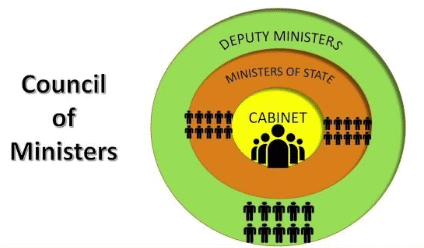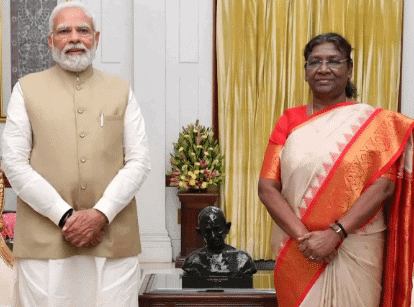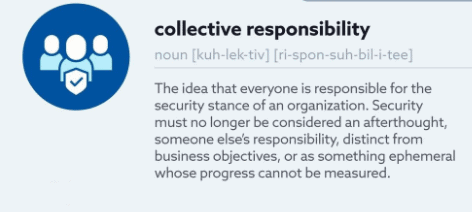Revision Notes: Prime Minister and Council of Ministers | History and Civics Class 10 ICSE PDF Download
| Table of contents |

|
| Prime Minister |

|
| Council of Ministers |

|
| The Cabinet |

|
| Prime Minister and President |

|
Prime Minister
In India, we have a parliamentary system where the Prime Minister is the real leader of the country. The President is the ceremonial head and acts on the advice of the Prime Minister.
Appointment of the Prime Minister
According to the Constitution:
- The President must invite the leader of the majority party in the Lok Sabha to form the government.
- If no single party has a clear majority, the President invites someone who can prove they have majority support in the House.
- The leader of the majority party in the Lok Sabha is then appointed as the Prime Minister by the President.
Council of Ministers

- The President appoints the Council of Ministers based on the advice of the Prime Minister.
- Traditionally, only members of Parliament can be appointed as ministers. If a person who is not a Parliament member is appointed as a minister, they must be elected or nominated to Parliament within six months of their appointment.
There are three categories of ministers:
Cabinet Ministers
- Cabinet Ministers are the most crucial group within the Council of Ministers. They handle important portfolios like defence, finance, and external affairs. Cabinet Ministers are responsible for formulating the government's policies and programmes.
Ministers of State
- Ministers of State may or may not have specific portfolios. Whether they are consulted by the Prime Minister is at the Prime Minister's discretion. Generally, Ministers of State do not participate in Cabinet meetings but may be invited to attend.
Deputy Ministers
- Deputy Ministers are junior ministers who assist the Cabinet and the Council of Ministers in their duties. They do not take part in Cabinet discussions.
- The Council of Ministers includes the Prime Minister and other ministers appointed by the President.
The Cabinet
- The Cabinet is a small group of senior party members included in the Council of Ministers.
- Cabinet Ministers hold significant portfolios and make key decisions regarding government policies.
- The Cabinet is the core of the administration, as it makes important decisions that other ministers must follow.
- The Prime Minister selects senior and trusted party members to be in the Cabinet and advises the President to appoint them.
Term of the Office
- The Cabinet and the Prime Minister are accountable to the Lok Sabha and can stay in office as long as they have the support of the majority of Parliament members. If the Lok Sabha passes a No-Confidence Motion against them, the entire Council of Ministers must resign.
- A Cabinet Minister is required to take an oath of Office and Secrecy, which means they promise not to reveal or share information with anyone.
- The Parliament determines the salaries and allowances for ministers from time to time.
Powers and Functions of the Cabinet
Administrative Powers
- The Cabinet is responsible for formulating and deciding the domestic and international policies of the government. They make decisions on important matters such as defence, finances, and foreign affairs. Individual ministers must consult the Cabinet on all significant issues.
- Once the Cabinet Ministers make a decision, it is communicated to the Ministers of State and Deputy Ministers, who implement the policies with the assistance of the bureaucracy.
- The Cabinet coordinates the activities of various departments to ensure the effective implementation of government policies.
- All major appointments made by the President are decided by the Cabinet under the Prime Minister's leadership. Appointments such as Judges of the Supreme Court and High Courts, Governors of states, Chief Election Commissioner, ambassadors, and other important officials are made based on the Cabinet's recommendations.
Legislative Powers
- Most bills in Parliament are introduced by the Cabinet, and these are known as Official bills, which take precedence over Private bills.
- Ministers and department secretaries respond to questions from Lok Sabha members.
- Cabinet Ministers are crucial in proposing amendments to the Constitution.
- The Ministry of Parliamentary Affairs, part of the Cabinet, decides when to summon Parliament, which is done in the President's name.
- The Cabinet also prepares the President's Special Address to Parliament and advises the President to issue Ordinances when Parliament is not in session.
Financial Powers
- The Finance Minister, a key Cabinet member, prepares the Annual Budget outlining expected income and expenditure for the financial year.
- The Cabinet oversees government expenditure and can present demands for grants and necessary income measures.
- A Money Bill can only be introduced in the Lok Sabha.
Emergency Powers
- The President can declare national, financial, and constitutional emergencies only with a written order from the Cabinet.
- The Prime Minister, as the elected leader, is the real head of the country, representing the people of India.
Prime Minister and President

- The President acts on the advice of the Prime Minister. Thus, while the President is the nominal head, the Prime Minister is the real head.
- The President summons and prorogues the Parliament on the advice of the Prime Minister.
- The Cabinet Ministers are chosen by the President on the advice of the Prime Minister.
- He advises the President on various appointments made on the posts of the Judges of the Supreme Court, the Governors and the ambassadors.
- The Prime Minister is a link between the President and the Council of Ministers. All important decisions made by the Cabinet members are communicated to the President by the Prime Minister.
Prime Minister and Cabinet
- The Prime Minister leads the Cabinet, overseeing its meetings and discussions.
- He is responsible for assigning specific portfolios to ministers and has the authority to request their resignations if necessary.
- The Prime Minister coordinates the activities of various Cabinet departments, ensuring smooth functioning and collaboration.
- When the Prime Minister steps down, all Cabinet members are required to resign as well.
Prime Minister and Parliament
- As the leader of the majority party in the Lok Sabha, the Prime Minister is considered the leader of the House.
- He acts as the chief spokesperson for the government in Parliament, defending its actions and decisions.
- When a minister is questioned, the Prime Minister steps in to defend him or her.
- In times of heated discussions on sensitive issues like communal tensions, Centre-State relations, or price hikes, the Prime Minister has the authority to intervene and bring the matter to a close.
Prime Minister as a Leader of the House
The Prime Minister plays a crucial role in leading the nation and representing the country in international matters. During times of national crisis, such as war, opposition parties rally their full support behind the Prime Minister.
- The Prime Minister is responsible for determining the country's foreign policy and presides over important meetings, including those of the Planning Commission and the Atomic Energy Commission.
Check on the Powers of the President
- In a coalition government, the Prime Minister may not have the full majority of the House, making their position potentially vulnerable.
- Opposition parties monitor the Prime Minister and the government by scrutinizing the work of various government departments and questioning ministers in Parliament.
- The press and public opinion also play a role in checking the power and authority of the Prime Minister.
Collective Responsibility

Article 75(3) of the Constitution addresses the principle of Collective Responsibility within the Council of Ministers. This principle signifies that:
- Decisions made by ministers in cabinet meetings are binding on all ministers, regardless of differing opinions.
- All ministers share joint responsibility for government policies, working as a team and defending one another.
- If a vote of No-Confidence is passed against any minister, the entire ministry must resign.
Individual Responsibility
- Accountability to the Prime Minister: Every minister is accountable to the Prime Minister and serves at their pleasure. Ministers must respond to all questions from Members of Parliament regarding their respective departments.
- Accountability to the President: All ministers are individually responsible to the President and hold office at the President's discretion.
- Responsibility for Policies: Ministers are responsible for any wrong policies they formulate and for breaches of secrecy. There have been instances in the past where ministers have resigned due to mistakes made by their departments.
- Answerability to the Public: The Prime Minister and the Council of Ministers are answerable to the public for every decision they make, despite their crucial role in formulating and executing laws and policies.
|
30 videos|197 docs|28 tests
|
FAQs on Revision Notes: Prime Minister and Council of Ministers - History and Civics Class 10 ICSE
| 1. What is the role of the Prime Minister in India? |  |
| 2. How is the Prime Minister appointed in India? |  |
| 3. What is the difference between the Cabinet and the Council of Ministers? |  |
| 4. What is the significance of the Cabinet in the Indian government? |  |
| 5. How does the Prime Minister work with the President of India? |  |















